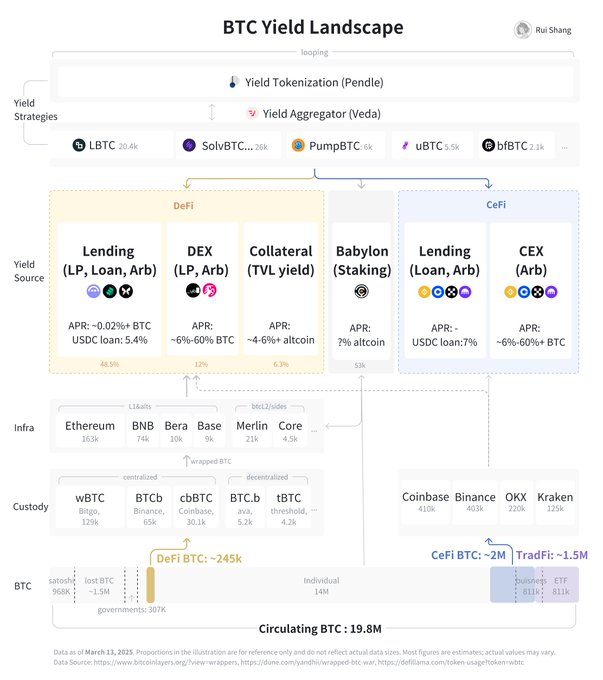比特幣收益解析:如何看懂實際收益?
比特幣的年化收益率(APR)看似十分誘人,但它可能建立在山寨幣激勵機制之上,隨時面臨崩塌的風險。
我們需要問幾個關鍵問題:收益是以BTC還是山寨幣支付?有哪些潛在風險?本金損失的可能性有多大?這種收益模式是否足夠穩定?隨著TVL的增長,收益會不會縮水?
本文將從以下幾個方面分析CeFi和DeFi中以比特幣計價的收益:
- 核心收益來源:量化交易、DEX流動性提供、借貸、質押、抵押、流動性質押代幣(LSTs)以及Pendle。
- 比特幣收益的新機會:@yieldbasis平臺。
未來展望:
•小失誤可能引發大問題。
•頂級量化團隊的稀缺性。
- 傳統金融、CeFi和DeFi的逐步融合,以及IPO帶來的新機會。

2025年的比特幣收益趨勢
核心收益來源
儘管收益模式多樣,但我們可以將比特幣的核心收益來源歸納為五大類:量化交易、DEX流動性提供、借貸、質押和抵押。

收益與風險解析
1)量化交易:收益與風險並存
量化交易的本質是“零和遊戲”,核心在於確保你的策略能夠持續盈利。套利方式包括資金費率套利、現貨與期貨基差套利、跨交易所套利和借貸套利,有時也涉及事件驅動型交易。這類交易需要充足的流動性,目前主要集中在傳統金融和中心化金融領域,而傳統金融與DeFi之間的套利還缺乏相應的基礎設施。
- 收益:根據資產規模、風險偏好和執行力不同,收益率也有差異。市場中性策略的目標年化收益率一般在4-8%,止損設定約為1%。頂級量化團隊則通過更復雜的風險控制,追求200-300%以上的年化收益率,同時將止損控制在10-30%。
- 風險:模型、判斷和執行風險並存,即使是中性策略也可能因市場波動而變成方向性賭注。此外,還需要強大的實時監控能力和技術支持,如低延遲、資金託管以及交易協議完善等,同時還需防範交易場所的風險。
2)DEX流動性:收益有限,風險明顯
去中心化交易所不僅支持套利交易,也承載了真實的交易需求。然而,目前僅有約3%的封裝比特幣(WBTC)存放在DEX中,原因在於供需兩端都存在限制。對於波動性較大的交易對(如WBTC-USDC),供給受無常損失影響,而需求則受到封裝比特幣使用摩擦和DeFi生態侷限的制約。
- 收益:收益率波動較大,例如@Uniswap 當前年化收益率為6.88%,高峰時可達兩位數。
- 風險:無常損失是主要問題,通常直接持有比特幣的收益會優於提供流動性。而許多新手LP容易被高收益率吸引,忽視了長期資本損失的隱性風險。此外,標準的DeFi風險(如智能合約漏洞)也同樣適用。
3)借貸:比特幣作為抵押品
比特幣在借貸市場中主要作為抵押品,用於借入美元或穩定幣以進行循環或槓桿交易,而不是直接用於賺取利息收益。這是因為目前市場對借入比特幣的需求較低。
- 收益:CeFi和DeFi的比特幣借貸利率普遍較低,年化收益率在0.02%-0.5%之間。貸款的貸款價值比(LTV)因平臺而異:傳統金融為60-75%,目前優惠利率為 2-3%,CeFi為33-50%,目前 USDC 利率約為 7%,DeFi 33-67%,目前 USDC 利率約為 5.2%。
- 風險:雖然低LTV可以降低清算風險,但也限制了資本效率。通過對衝策略可以進一步降低風險,但CeFi和DeFi平臺本身的安全性仍需重點關注。
4)質押:賺取山寨幣獎勵
@babylonlabs_io處於一個獨特的地位,其質押活動為相關權益證明(PoS)鏈的安全性做出了貢獻。
- 山寨幣收益:收益以山寨幣計價,年化收益率未知。
- 風險:Babylon協議需要進行多次安全審計,並在系統上線後披露預估的質押收益率。如果Babylon代幣發行失敗,整個生態系統的可持續性將受到威脅。
5)抵押:流動性挖礦
將比特幣提供給DeFi、比特幣二層網絡(BTC L2)等作為鎖倉資產(TVL),以賺取山寨幣獎勵。
- 山寨幣收益:收益各異,一些為5%-7%,但大額持有者通常能獲得更優惠的利率。
- 風險:不同協議的可靠性和歷史記錄各不相同。每個協議對鎖倉時間和資本要求也有所不同。
除了以上五種收益來源外,還有流動性質押代幣(LSTs)和收益代幣化平臺:
6)流動性質押代幣:複利收益
比特幣“LSTs”項目(如@Lombard_Finance、@Pumpbtcxyz 、@SolvProtocol、@Bitfi_Org)起源於Babylon生態系統,現在發展為具有複雜收益策略的跨鏈收益比特幣。@veda_labs 則充當聚合接口。
主要以山寨幣計價的收益:
- 收益主要以山寨幣計價,包含Babylon質押獎勵、不同鏈上的積分、$Pendle,以及通過第三方量化策略獲得的收益。此外,平臺還會提供自己的代幣作為額外激勵。
- LSTs的低流動性可能導致連鎖清算風險。在鑄造、贖回、質押和跨鏈橋接過程中,存在單點故障的隱患。對自身及其他山寨幣收益的高度依賴,表明收益波動性較大。
7)收益代幣化:如何通過交易賺取收益
@pendle_fi 是一個專注於LSTs(流動性質押代幣)收益提升的平臺,目前管理著價值約4.44億美元的比特幣鎖倉量(TVL)。在這個平臺上,交易者可以鎖定固定收益(類似於現貨產品),對衝利率波動,還能靈活交易收益頭寸(做多或做空)並獲得收益流動性。
收益來源:
- 收益波動較大。YT(收益代幣)持有者可以賺取LST的基礎收益、兌換手續費、固定收益以及平臺發放的$Pendle代幣。
潛在風險:
如果$Pendle代幣價格下跌,用戶參與度會受到顯著影響。Pendle平臺的收益波動性依賴於多個山寨幣激勵層級,包括其自身的$Pendle代幣,這使得收益模式變得更加複雜和不穩定。
比特幣收益的新機會:Yield Basis簡介

Yield Basis如何運作?
正如前文所述,山寨幣計價的收益模式不可持續,而真正的比特幣計價收益不僅稀缺,還伴隨較高風險。量化交易團隊需要足夠的流動性,但目前去中心化交易所(DEX)的流動性支持尚顯不足。
- 什麼是Yield Basis(YB):YB是一個自動化做市商(AMM),通過減少無常損失,鼓勵用戶提供比特幣流動性,同時支持跨平臺套利和真實交易活動。
- 比特幣收益的基礎設施:根據過去6年的數據模擬,YB平臺可以實現平均年化收益率(APR)約為20%(淨收益),在牛市中甚至更高。YB還可以與其他LSTs(流動性質押代幣)結合使用,為其提供真實的比特幣收益敞口,同時支持與Pendle平臺的收益協同。
- 高級交易策略的場所:YB計劃逐步建立一個高流動性的交易場所,以支持複雜的量化交易策略。同時,它還提供了循環收益的機會,幫助提高比特幣在借貸協議中的借貸利率。目前,@aave平臺上有32.86億美元的WBTC,但借貸利率僅為0.02%。
- 面向普通用戶的比特幣交易場所:YB的長期目標是為封裝比特幣(wrapped BTC)建立最深的鏈上流動性池,並與CeFi(中心化金融)交易平臺展開競爭。
如何解決無常損失問題?
核心機制:AMM嵌套AMM
- 當用戶將比特幣作為流動性存入YB時,系統會通過借入一半的LP價值並不斷加槓桿,創建一個穩定幣-比特幣池,並通過再平衡模型維持穩定。池中產生的收益和50%的費用將用於補貼池的再平衡操作。
APR計算公式:
- APR = 2 * 池收益 - (借貸利率 + 再槓桿損失)固定成本主要是針對crvUSD的借貸利息,但由於系統會利用這些資金進一步獲取收益,因此成本是可控的。波動性越高,再槓桿損失會增加,但同時池收益也會提高,只要波動性不超過系統設定的最高流動性範圍,該策略依然有效。參數的選擇非常重要:激進的參數可以提高收益,但再槓桿損失的風險也會增加,反之亦然。
通過$YB代幣提升收益:
- 流動性提供者(LP)可以選擇直接賺取池費用,或者通過質押賺取平臺發行的YB代幣獎勵。當YB代幣的吸引力增加時,更多LP會選擇放棄池費用,從而提高整體池的年化收益率(APR)。
未來趨勢展望
比特幣收益的生成方式將變得更加專業化,未來的發展將側重於風險可控、以比特幣計價以及面向機構投資者的產品。能夠在監管框架內創新,同時提供深度流動性和穩定收益、避免過度風險的參與者,將在市場中佔據主導地位。
小失誤可能引發巨大危機
- “沒有什麼是牢不可破的——只是還沒有成為目標。” BTC 面臨著跨多個風險層的日益複雜的攻擊:CEX 信任委託、自託管網絡釣魚,如果將它們投入使用的話——智能合約漏洞(權限、邏輯、算術)和機制風險(清算、本金損失)。社會工程通過利用關係和界面構成嚴重威脅。主要的 BTC LP 甚至需要鏈停止和橋接塊。聽起來違反直覺,公共區塊鏈和高流動性、無需許可的協議對於其安全性來說並不理想。 @0xAquariusCap 提出了一個 安全框架 實現全面的測試、監控和風險跟蹤。
頂尖量化團隊的稀缺問題
- 真實的比特幣計價收益無疑更具吸引力。儘管去中心化交易所(DEX)的流動性提供者仍處於早期階段,但量化交易仍是市場的主導力量。一些團隊將其量化策略打包成比特幣收益產品,並從外部投資者處獲得資金支持。然而,高頻套利的能力可能受限,頂尖團隊通常會將這些高效策略保留在內部,不接受外部資本投資,這也導致了市場上的“逆向選擇”。即便如此,市場中性和其他低風險策略依然是非常適合作為比特幣收益產品的選擇。
傳統金融、中心化金融與去中心化金融的融合及IPO機會
- 隨著比特幣市場的流動性不斷增強,我們正在看到傳統金融(TradFi)的穩健性、中心化金融(CeFi)的便利性和去中心化金融(DeFi)的創新性逐步融合。2025年1月,@coinbase 推出了由@MorphoLabs 支持的比特幣抵押貸款,這標誌著CeFi正在將DeFi的機制拓展到更廣泛的用戶群體。這一趨勢為機構級資產管理公司提供了發展和上市的機會。那些以安全為核心、披露透明風險並擁有可信治理結構的公司,將能夠建立強大的品牌形象,為傳統金融資產管理公司提供穩定的收入來源,並服務於高淨值客戶、養老金計劃和捐贈基金等多樣化的客戶群體。
聲明:
- 本文轉載自 [Rui],著作權歸屬原作者 [Rui],如對轉載有異議,請聯繫 Gate Learn 團隊,團隊會根據相關流程儘速處理。
- 免責聲明:本文所表達的觀點和意見僅代表作者個人觀點,不構成任何投資建議。
- 文章其他語言版本由 Gate Learn 團隊翻譯, 除非另有說明,否則禁止複製、傳播或抄襲經翻譯文章。
相關文章

區塊鏈盈利能力和發行 - 重要嗎?

比特幣年第二章

Notcoin & UXLINK:鏈上數據比較

Solv協定:集中式去中心化金融趨勢下的資產管理新範式

位元層:使用 BitVM 比特幣 Layer 2解決方案
